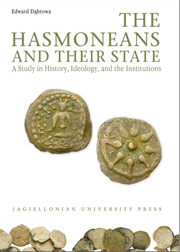Book contents
- Frontmatter
- Contents
- Introduction
- Abbreviations
- Part I Judea under the Hasmoneans (167–63 BCE)
- Part II The Institutions of the Hasmonean State
- I The Ruler
- 1 The Royal Priesthood or the Priestly Monarchy
- 2 The Priesthood
- 3 The Kingship
- 4 Succession
- 5 The Royal Family
- 6 The Court
- 7 The Capital City
- 8 The Palace and the Baris
- 9 Propaganda and Self-Presentation
- II The State
- Part III Society
- Conclusions
- Bibliography
- Index of Personal Names
- Index of Place Names
- Index of Ancient Sources
- Electrum - Volumes Published
- The Hasmonean State
9 - Propaganda and Self-Presentation
from I - The Ruler
Published online by Cambridge University Press: 05 September 2014
- Frontmatter
- Contents
- Introduction
- Abbreviations
- Part I Judea under the Hasmoneans (167–63 BCE)
- Part II The Institutions of the Hasmonean State
- I The Ruler
- 1 The Royal Priesthood or the Priestly Monarchy
- 2 The Priesthood
- 3 The Kingship
- 4 Succession
- 5 The Royal Family
- 6 The Court
- 7 The Capital City
- 8 The Palace and the Baris
- 9 Propaganda and Self-Presentation
- II The State
- Part III Society
- Conclusions
- Bibliography
- Index of Personal Names
- Index of Place Names
- Index of Ancient Sources
- Electrum - Volumes Published
- The Hasmonean State
Summary
Kings striving to make a strong presence in their subjects' daily life were a characteristic feature of the Hellenistic period. Such presence had impact on how the king was perceived by his subjects and assured him a more or less permanent place in social awareness and memory. Therefore, every ruler tried as best he could to publicize and perpetuate the memory of his name and acts, and especially his image. Its use on a wide scale and in a variety of forms became common practice. Portraits of rulers were omnipresent: on coins, in public places, temples, and homes. Multiplied in innumerable copies, such portraits made the ruler almost physically present wherever they were found. The phenomenon was characteristic of all rulers and even usurpers.
Nor were the Hasmoneans averse to the idea of promoting their name, even though their nation's cultural and religious traditions posed some obstacles in this respect that hindered no other contemporary monarch. Clearly the greatest difficulty stemmed from the rigorously observed Jewish prohibition to make or display images of people and animals. The prohibition robbed the Hasmoneans of a chance to use their own images as a propaganda tool. Out of respect for tradition, they made no attempt to circumvent the ban; instead they were compelled to seek other means to present themselves to subjects. Available historical evidence allows the conclusion that their activity in this field was not without certain achievements and took on various forms.
- Type
- Chapter
- Information
- The Hasmoneans and their StateA Study in History, Ideology, and the Institutions, pp. 134 - 146Publisher: Jagiellonian University PressPrint publication year: 2009



